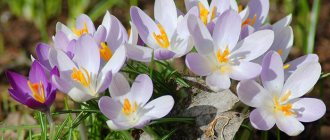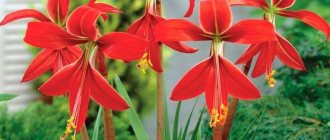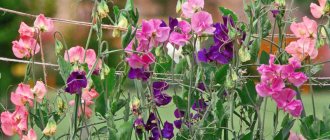Autumn crocus is a herbaceous perennial plant, a member of the iris family. Autumn crocus is not as common in gardening as spring crocus. For gardeners who want to enjoy the blooming of garden flowers in the autumn, when most plants have already bloomed, I recommend autumn crocuses. The autumn crocus, in spite of the cold, wind and pouring rain, opens its beautiful exotic flower. It’s rare that anyone manages to remain indifferent to a delicate flower that sometimes gives us its pristine, enchanting beauty in the autumn. Autumn crocus blooms during the golden autumn, in September, October, November.
Autumn crocus is an ephemeroid; only under favorable conditions does the plant appear on the ground surface and begin to grow. Under unfavorable conditions, plant development occurs deep in the soil in the corm. Most types of autumn crocuses begin to grow in moist soil and temperatures of 4...8°C.
The crocus corm is covered with leathery, dry or filmy scales. Autumn crocus flowers look like wide or narrow glasses, reaching 20 cm in height. The fruit is a 3-locular capsule, the seeds are round. The life cycle of the autumn crocus is similar to the life cycle of the crocus.
Autumn colchicum (colchicum) is a plant of the lily family, which is very often confused with crocus. These garden plants differ in color and number of stamens. In order not to make a mistake when buying bulbs, you need to know that crocus bulbs have a maximum diameter of 2.5 cm, and the colchicum bulb is much larger.
Caring for crocuses in open ground
We will tell you below how to grow crocuses strong and healthy after planting. But know that you won’t spend a lot of effort and a lot of time.
Watering crocuses
There is no need to water saffron regularly; besides, it is very sensitive to stagnation of moisture. Crocuses need a lot of water during the spring and autumn flowering periods. But nature helps us there too: in one case, the snow melts and gives water, in another - autumn rains. Additional watering is organized if the winter was not snowy and the autumn was not rainy enough. But even with insufficient moisture, crocuses successfully go through the growing season. They will only become smaller in height. In summer, during periods of calm, crocuses do not need water; they prefer to rest in a dry environment.
Fertilizer and feeding
The basis for growing all plants in the garden is fertilizing, therefore, when thinking about how to grow healthy and beautiful crocuses in your garden, you need to prepare a complex of mineral fertilizers. Feeding crocuses has some nuances. Fresh organic fertilizers are not allowed. They cause various diseases. Peat, completely decomposed manure and other mineral fertilizers will be preferable.
In early spring, during the period of active growth, you need to sprinkle fertilizer on the melting snow. At the beginning of the vegetative period, urea can be introduced. Later, an excess of nitrogen will cause a sharp growth of leaves, which will provoke the appearance of unwanted fungal diseases in wet weather. After half a month, fertilizers rich in phosphorus and potassium should be added to the planting site. They will contribute to better flowering and the formation of strong and healthy corms.
Care after flowering
Like many bulbous flowers, these flowers lose their leaves by mid-summer, so you need to take special care of the crocuses in your garden after they bloom. If you have no plans to transplant the plant to a new location, then you can get by with removing the wilted foliage. If the decision was made to dig up crocuses, then the best time is July.
The procedure looks like this:
- Remove blooms that have faded so that the plant does not have to put extra effort into trying to form seeds.
- Gradually reduce the amount of watering. So the outflow of all nutrients will gradually go into the corm
- When the leaves turn completely yellow, the bulb needs to be dug up and dried a little at room temperature.
- Next, remove scales and discard diseased and damaged daughter tubers.
- Bulbs should be stored in a well-ventilated area at a temperature within 20 °C.
Transplanting crocuses
Due to the abundant formation of daughter bulbs in crocuses, they need to be planted. Otherwise, a large nest of shoots will form. They become crowded, they become deformed, the flowers become smaller, and the plant loses its aesthetic appeal.
The bulbs should be dug up after the leaves have completely died in mid-July to early August. Store in a warm, well-ventilated area until transplantation. They need to be planted in flower beds in August or September at a distance equal to two to three corm diameters from each other. The hole must be dug to a depth equal to three bulbs in height.
Storing Crocus Bulbs
The extracted corms must be cleaned of soil, dead roots and scales, and then laid out in one layer in a box or box. The smallest ones can be placed, for example, in candy boxes. Until August, planting material should be stored at a temperature of +22 °C and not lower, since it is under this regime that flower buds are formed. In August, the temperature should be lowered to +20 °C. In a week - up to +15 °C. But such conditions are difficult to create at home, and they are ideal, because only in specialized farms can the thermal regime be adjusted. Under our usual conditions, crocus bulbs need to be placed in a dark, dry place with good ventilation and room temperature.
Did you know? To obtain 1 kg of saffron spice, you need to collect about 600,000 stigmas from newly blooming crocus flowers. Hence the expression “as dear as saffron.” A very justified statement.
How to store planting material before planting in autumn
Crocuses can be grown in one place for several years. It is recommended to dig up bulbs every 3-4 years in order to change the site, select newborns, and remove diseased or damaged plants.
A group of crocuses that bloom in early spring goes into a dormant state by mid-summer. This is expressed in the drying out of the above-ground part of the flower.
In July, in dry weather, crocus bulbs are carefully dug out of the ground. The bulbs are separated from the roots, air dried and sorted. Sick specimens are thrown away, the baby is set aside for growing (planted in the ground or pots at the same time as adult crocuses).
Crocus planting material intended for autumn planting at home is stored in a dry and dark place, at room temperature, similar to tulip bulbs. Crocuses are scattered into cardboard boxes in one layer, sprinkled with sawdust or wrapped in toilet paper.
Colchicum care
Garden hibiscus - features of growing in open ground
There is nothing difficult in caring for such a plant. Watering should be done only when the plant is blooming, and then this should be done only during periods of prolonged drought and heat. At other times, such a flower should not be watered, because natural precipitation will be enough for it. Remember to avoid over-wetting the soil.
Feeding is done 2 or 3 times per season. To do this, use complex mineral fertilizer (30 grams per 1 square meter), and prepare a weak solution (2 grams of substance per 1 liter of water). Remember that the fertilizer must contain nitrogen. In autumn, compost should be added to the soil. It is also necessary to systematically loosen the soil surface and remove weeds.
How to transplant
This flower can be grown in the same place for quite a long time (about 6–7 years), then it must be transplanted to a new place. However, experienced gardeners advise replanting at least once every 2 or 3 years, otherwise the bulbs will grow and become very crowded, and the flowers will become smaller.
The best time for both planting and replanting such a plant is August. At this time, the crocus is at rest. However, the bulbs must be dug up in advance, after the leaf blades turn yellow, as a rule, this time occurs in the second half of June. You need to carefully remove the soil from the bulbs, and also remove the remaining leaves. Separate the daughter bulbs from the mother bulbs, keeping in mind that the latter are not used for subsequent planting. Then the bulbs should be carefully washed in running water, after which they are placed in a solution of potassium manganese for disinfection for 30 minutes. Then the tubers need to be thoroughly dried and stored in a dry, dark place, while the air temperature should be approximately 24 degrees. With the onset of August, the separated daughter bulbs must be planted in the ground. In this case, the planting rules are exactly the same as those used for planting colchicum (described above). At the same time, do not forget to fertilize the soil first.
Diseases and pests
Snails and slugs can live on such a flower. Such pests feed on its leaves. If the soil is almost constantly waterlogged, this can cause the development of gray rot. In order to avoid the appearance of slugs, the surface of the rows must be covered with a layer of crushed shells, fine gravel or egg shells. You can also place plastic gutters around the perimeter of the site into which you need to pour water. They will become an insurmountable barrier for slugs and snails.
If the crocus is regularly watered abundantly for a long time, gray rot, which is a fungal disease, may appear on it. If the flower is not very infected, you can try to cure it. To do this, it is recommended to treat the bush with Champion, Topaz, Kuproxat or another product with a similar effect. Before treatment, those parts of the plant that are severely affected should be cut off and burned. Then you need to reconsider the watering schedule.
Reproduction methods
Crocuses reproduce by daughter bulbs , the so-called children, which are separated from the mother plant during development. They bloom only after 3 years. Every year, babies are formed near the mother's bulb, and there are too many of them. As a result, crocus flowers begin to shrink. That is why, every five years, overgrown clumps of crocuses must be dug up and planted.
In rare cases, seed propagation can be used. It takes a lot of time and therefore, for the most part, it is used by breeders to develop new varieties.
Features of crocuses
Greenhouse tomatoes for beginners: features of growing and watering tomatoes in a greenhouse
Continuing to further understand the differences between autumn crocus and colchicum, you should study all the characteristic features of the first plant
When discussing this plant, special attention should be paid to the following points:
- Feeding.
- Landing.
- Watering.
- The soil.
Feeding. The ideal fertilizing option for crocus is mineral fertilizers. This fertilizer can be used even earlier in the spring, or rather, water the plant with it, even if there is still snow on the ground. It is advisable to additionally mulch the soil in which the crocus grows, using peat chips or ordinary fallen leaves. This is necessary for the plant to survive severe frosts during winter. If the crocus bulb did not survive the frost and died, there is no need to throw it away immediately, since the buds that surround it may well give birth to offspring.
Watch a video about what crocuses look like.
Landing. Often, the depth of planting of a crocus is determined depending on the size of its bulb. If the bulb is large, then it needs to be buried 10 centimeters into the ground; if it is medium in size, then 5 centimeters is enough. The gap between the bulbs should be at least ten centimeters. When planting this plant, keep in mind that planting too deeply can significantly slow down vegetative propagation.
Watering. Housewives who grow crocuses must constantly ensure that the soil is always properly moistened. And as soon as sprouts begin to appear from the corms, they need to be systematically watered. But, after a while, you need to water only as needed. Try to let the soil dry out between waterings.
The soil. For a plant to develop well, it needs to grow in fertile soil. If you initially plant your crocus in good soil, then when it blooms, you will not need to use additional fertilizers to stimulate growth. And also we should not forget that many people really like the way the colchicum blooms.
Crocus is also popularly called saffron. It has long been known that saffron is one of the excellent spices for preparing very tasty dishes. But such a spice cannot be collected from ordinary flowers that grow in our flower beds. For culinary purposes, you need to grow a special seed crocus.
Most crocuses bloom in autumn. Autumn varieties of crocuses begin to bloom only in leaf fall. Of course, they cannot please you with their flowering for too long, but even in this short period, these flowers will give you a small piece of summer and warmth. Most often they are used for the following purposes:
- to elegantly decorate the lawn;
- as an interesting accent in small groups of different colors;
- to highlight the color scheme along the edges of flower beds;
- for decorating water bodies.
The uniqueness of this plant also lies in the fact that it can also be grown as an indoor crop. But, you should take into account the fact that as a houseplant, the flowering period will shift. By the way, the flowering period depends on the time of planting the bulb, and not on the natural life cycle.
Description of the colchicum
When choosing an area for planting colchicum, it is best to give preference to a sunny area. This plant will do well in absolutely any soil:
- alkaline;
- sour;
- neutral;
- in clay.
When planting, you should adhere to the following recommendations:
- Before planting, it is appropriate to first dig up the area and add a little humus there.
- When planting a plant, it is advisable to fill the soil generously with superphosphate.
- The distance between the bulbs should be at least 15 centimeters.
When you are looking for an answer to the question whether crocus and crocus are the same thing or not, then first of all you will find information that crocus is a poisonous plant. But don’t think that this is a reason to refuse to plant these extremely beautiful flowers. To protect yourself and your loved ones, just make sure that the flowerbed is not accessible to children and animals. And also when working with such a plant, be sure to wear special gloves. By following these tips for growing colchicums in your flowerbed, you will only get pleasure and can be absolutely calm.
If you don’t know whether it’s better to choose an autumn crocus or a colchicum for your garden, then you can easily choose two options at once. Because their combination has a special charm and sophistication. To understand why Colchicum is poisonous, you can search for such information on the Internet.
How to plant crocuses in open ground correctly
Features of growing apricot
In order to properly plant crocus corms in open ground in the fall, you need not only to correctly carry out the procedure itself, but also to complete the preparation.
So, in general, the procedure can be divided into several key stages:
- choice of location;
- site and soil preparation;
- preparing bulbs;
- the landing itself.
Each point will be discussed in detail below.
Selection of location and soil
Where is the best place to plant crocuses in your garden? When choosing a place to plant corms, keep in mind that flower culture likes areas that meet the following requirements:
- The soil is fertile and nutritious.
- The soil is well drained, without excessive moisture (excess moisture will cause the bulbs to rot).
- The soil is nutritious sandy loam or loamy.
- The soil has a neutral reaction (pH 6.5-7).
- The place is well lit by the sun.
- The site is protected from strong and cold winds.
Soil preparation
If the soil at your dacha or the site of a private house does not meet the above requirements, then you must take some measures. After all, if crocuses are grown in open ground in optimal conditions for them, then they will undoubtedly delight you with their beautiful and lush flowering.
Preparing a garden plot for planting crocuses in the fall is carried out according to the following scheme:
- Using a shovel, you need to dig up the area where you plan to plant the bulbs. However, if the soil needs to be improved, then before digging you need to add certain substances to the site depending on the problem (if the soil is ideal, then you can just dig): For heavy, clay soil, you need to put sand on the soil (1 bucket per square meter) and compost or humus (1 bucket per sq.m.).
- If the soil is too light, sandy, you need to add compost/or humus (1 bucket per sq.m.) and preferably lowland peat or leaf humus (the same amount).
- For depleted, infertile soil, it is recommended to add organic fertilizers - compost or humus (1-1.5 buckets per sq.m.), as well as mineral fertilizers - superphosphate (40 grams per sq.m.).
Preparing Crocus Corms
Before planting in open ground, it is recommended to prepare crocus corms. Pre-planting treatment helps eliminate pathogens of dangerous diseases from planting material, which will prevent the development of the disease, and will also serve as an excellent disease prevention.
To treat crocus bulbs, it is recommended to soak them in a fungicide solution, for example, “Fundazol”, “Maxim Dachanik”, “Vitaros”.
It is also useful to soak in a solution of a growth stimulator; such preparation will increase the immunity of the bulbs. For example, it can be treated in Epin-Extra or Zircon solution.
There is no need to remove the covering scales from the bulbs. The exception is the scales, which almost fall off on their own; they can be carefully removed.
Planting scheme
So, if you have completed the preparation of the site and material, it’s time to get down to business. Standard scheme for planting crocus bulbs in open ground in the fall:
- Make holes in the prepared area. At what depth and at what distance should the onions be planted? the distance between the holes is 3-5 centimeters from each other (such a small gap is due to the fact that crocuses feel good in joint “family” plantings);
- the depth of the holes is 3 times the height of the crocus bulb (that is, if the height of the corm is 2 centimeters, then you need to multiply 2 × 3, it turns out 6 - this is the planting depth).
Place a small handful of sand on the bottom (this is especially important if moisture stagnation or waterlogging is possible). Place the bulbs bottom down, it should stand straight. Fill the hole with soil. Lightly compact with soil. Water. Mulch the flower garden.
Where to start breeding?
If you have little experience in growing flowers or simply do not have the ability to carefully monitor all changes in your pets, you need to choose unpretentious plants. Primroses work well for this, particularly crocus. Planting and care in open ground will not bring much trouble. The main thing is to choose the right place and periodically seat it.
Saffron reproduces both by underground root system and by seeds. The first option is used more often.
Rules for growing and care
When to plant Colchicum
Corms are planted in sun or partial shade in August. The bulbs are buried to 3/4 of the height of the bulb. Plants prefer loamy soil and can grow in one place for many years.
Colchicum care
In spring and autumn, if there is no rain for a long time, watering will not hurt. In summer, watering is not required. In spring and autumn, if desired, you can feed the plants with Ntroamophoska 40 - 50 g/sq m. But simple, unpretentious varieties, as a rule, do without this, develop and bloom well.
To protect against freezing, non-resistant varieties, including white-flowered and terry ones, for the winter it is advisable to mulch them with a layer of humus, cover them with leaves or spruce branches.
It is important to remember that in spring Colchicum wakes up very early, so you should remove mulch, foliage or spruce branches in time
Types and varieties
Not all crocuses bloom in early spring. Some species bloom when the trees have already shed their leaves, and most large herbaceous plants have already flowered and withered. You can combine both types in one area. Then the delicate cups will greet the long-awaited spring, and then see off the summer.
The most popular varieties among gardeners are listed in the table.
| Flowering time | Crocus name | Description |
| Spring | Spring | A soft lilac flower, sometimes with dark veins, often found in the wild of the Alps. The most popular subspecies are: Nigro fight and Flower record, Klaus, Pickwick. |
| Two-flowered (Scottish) | Color ranges from white to blue with dark brown streaks. Flower growers prefer hybrids: Alexandri, Parkinsoni, Dorothy, Albus and Fairy. | |
| Korolkova | Bright orange petals with red veins distinguish this Central Asian subspecies. The selection of hybrids was actively carried out in the Soviet Union, which is why they have the following names: Glory to Samarkand, Kiss of Spring, Tiger. | |
| Crimean | The petals are faded on the outside, bright white on the inside with a yellow center. | |
| Sieber | Warm-loving and whimsical flowers of a tricolor color with an orange center. Breeders distinguish the following varieties: Bovlesis white, Atticus, Tricolor, Prince. | |
| Adam | Brought from the foothills of the Caucasus, Dagestan and Iran. Comes in a wide variety of colors. | |
| Tomasini | A wild subspecies that grows in Hungary and the lowland regions of Yugoslavia. The petals are lilac-pink, and after opening they look like a star. One bulb can produce up to 6 peduncles. The most popular hybrids are: Lylek Beauty and Whitewell Purple, Giant. | |
| Golden | In the wild, these are small, almost undeveloped thin leaves that barely frame a large yellow inflorescence. Widely distributed in Asia and the Balkans. Breeders have developed several hybrids with stunningly beautiful calyx colors: Blue Pearl, Princess Biatrix, Blue Bonnet, Cream Beauty, Marietta, Violet Queen, Schwanenburg Bronze, Bowels, Nanette, Lady Killer. | |
| Dutch grandiflora | These are the real giants of the primrose world. Bright candy colors from lemon yellow to fluorescent purple. Several dozen subspecies of these spring flowers have been bred. The most popular: Albion, Vanguard, Jubilee, Sniper Banner, Zonatus, Kathleen Parlow. | |
| Yellow | The flowers are rich orange shades, the leaves are small, the upper part of the bulb rises high above the ground. | |
| Autumn | Beautiful | It has long leaves up to 30 centimeters. Colors of all shades in a gradient from white to dark blue. The hybrids favored by flower growers are called: Albus and Artabir. |
| Pretty | Frost-resistant subspecies with delicate large white cups with dark veins on the outside of the petals. | |
| Banat | A dark purple variety with sharp silver-green leaves. | |
| Pale ocher | Neat, delicate inflorescences, clustered close to the bulb. | |
| Holofloral | Rarely beautiful varieties with purple inflorescences. | |
| Long-flowered | A late variety that blooms in late autumn. With a long peduncle, the leaves are small, closely pressed to the bulb. | |
| Smoothed | One of the late-flowering varieties, opens its petals in early November. | |
| Saffron | One of the most expensive, beautiful and noble species. Valued for its delicate scent and stamens, which are an exotic spice. |
Seeds, bulb, flower
A large box with seeds, covered in the middle of a bunch of leaves, will appear simultaneously with them only next year.
An interesting feature of this plant is its “peduncle”, because it is not a stem at all, as it seems at first glance, but a highly elongated flower tube into which all six of its petals grow together. The ovary itself is located inside the corm, which is hidden underground.
This is what allows the germinating seeds to safely overwinter and continue development in the new season.
The most interesting feature of Colchicums is that they always bloom unexpectedly. So even if you have been cultivating this plant for several years and are not going to be surprised by the sight of “naked” flowers without leaves, their appearance will still take you by surprise, because they are unpredictable.
As if by magic, lilac, blue or white buds appear from the ground overnight. The leaves that grew in the spring dry up by July and over the summer you can simply forget that anything grew here.
Basic information
The main flowering time is two to three weeks in spring, but there are also varieties that bloom in autumn.
Crocus is a low-growing plant, reaching a height of 10 cm. The root system is represented by corms up to 3 cm in diameter. The stem is not developed. The leaves are basal, narrow, collected in a bunch and covered with scales.
Flowers are solitary, rarely 2-3 from one bulb. Reach 5 cm in diameter, goblet-shaped. The fruits are capsules with three “nests” for seeds. The seeds themselves are small and brown in color.
Caring for crocuses in open ground - growing rules
Crocuses do not require special care, so they can be called fairly unpretentious flowers. However, to make them look neater and bloom profusely, they still need some gardening manipulations, namely:
- if necessary, loosening and weeding from weeds (in early spring and after flowering);
- moderate watering;
- timely feeding.
In the spring, crocuses practically do not need watering, but after they bloom, closer to summer, if the weather is dry, then at least once a week they should be slightly moistened (especially if the soil is too sandy), but not Do not overwater in any case, so that the tubers do not rot. If the autumn is dry, it will be great to carry out a couple of moderate waterings.
Timely application of mineral fertilizers can contribute to more productive development of plants.
Every year it is best to fertilize crocuses 2 times:
- In early spring there is still snow, that is, before the start of the growing season, it is necessary to use nitrogen fertilizers, such as urea (carbamide) or ammonium nitrate, or better yet, complex nitrogen-phosphorus fertilizers, such as nitrophoska.
- Before or after flowering, it is reasonable to fertilize the plant with any complex potassium-phosphorus fertilizer, for example, superphosphate (preferably double) or potassium monophosphate; it is also good to feed it with ash (just sprinkle in a circle).
Features of planting autumn crocuses
Before planting crocuses, you need to prepare a site for them. Mix sand or fine gravel into the soil to improve drainage, and add mature manure and leaf soil to poor soil. Autumn crocuses will also respond with gratitude to the application of phosphorus-potassium fertilizers (instead of nitrophoska it is better to use superphosphate and potassium nitrate). It is better not to use peat or slak it with lime. In those areas where there is a high risk of getting wet, make raised ridges or lay drainage at a depth of 30-40 cm.
Autumn-flowering crocuses require a slightly different approach to planting: if spring ones are planted in August-September, then autumn-flowering ones need to be purchased before flowering, which traditionally begins in September. The best time for them is from June to the end of the first ten days of August. Do not buy flowering bulbs - they will be weakened and will require several years to recover. Before planting, inspect the bulbs again: they should be heavy, with dense shells, not crushed and soft, with a clearly visible renewal bud (small tubercle). Autumn-blooming crocuses should "wake up" soon, and if buds are not visible on them, it is better not to plant them at all, or plant them in a pot and watch for signs of growth.
Autumn crocuses are planted only in groups of 5 or more, placing the plants at a distance of 5-6 cm between plants. Crocus bulbs are planted at a traditional depth equal to twice the height of the bulbs themselves (from 5 to 15 cm). On heavy soil, leave a distance from the top of the bulb to the edge of the soil equal to the height of the bulb.
It is not necessary to strictly monitor the centimeters: crocuses, unlike many bulbous ones, form retracting roots and the young bulbs themselves will settle in the soil at a comfortable depth. After planting, mulch the soil with sand to protect against slugs. Be sure to mark the planting location with sticks or other markers.
Diseases and pests
The worst pests for crocuses are rodents and moles. In certain years they can destroy up to 90% of plantings. The bulbs damaged by them rot, as evidenced by poor regrowth in the spring and a depressed appearance. In this case, all planting material should be dug up and the damaged material should be sorted, which is then dried and processed.
To prevent the appearance of mice and moles, do not leave turf areas or groups of perennials at a distance of 3 meters from crocuses; mice most often make their nests in them.
To combat rodents, you can also use special loose baits, which are placed in places where they appear.
Of the insects on crocuses, cutworm butterfly caterpillars are quite common. They damage roots and bulbs. They are very easy to detect in the fall when weeding. Thick gray caterpillars are preparing for pupation at this time; they are collected and destroyed.
Crocus plantings are very rarely affected by diseases, but recently viral lesions can be increasingly found on them. They are characterized by damage to flower buds, which is expressed in white spots on the glasses and in deformed bracts. Viral diseases are transmitted by insects that feed on plant sap. Affected specimens should be dug up and destroyed.
Conditions favorable for autumn crocuses
Autumn crocuses are much more flexible in their light requirements. Sharoyan and valley crocus love shade or partial shade, but other species are better provided with diffused lighting, sunny and bright places, or at least a semi-shaded location. For autumn crocuses, a growing strategy with a sunny location in spring and autumn and a shaded location in summer is suitable.
Crocuses do not like winds and drafts, so protected areas are chosen for them. The thing is that the flowers of these plants are sensitive to cold autumn winds, and the more protection their “neighbors” provide them, the better.
The location for planting autumn crocuses must be selected so that during the dormant period they do not suffer from getting wet and grow in dryness and warmth. That is why you need to choose either elevated, well-drained places (for example, on alpine hills and rockeries). Another option is to lay drainage during planting.
Pay attention to the soil too. For crocuses, choose light, loamy soils that drain water well
The only exception is the Dutch varieties and hybrids, which tolerate even heavy soil. Be sure to make sure that the soil is neither acidic nor alkaline: crocuses love neutral soils. But they are not so demanding when it comes to fertility: the richest soils and rather poor soils are suitable for crocuses.
Crocuses: early varieties (video)
Also, during wet weather, an outbreak of fungal diseases can occur. Most often, corms suffer from this. They shrink and soften, and colored spots appear under their shell.
Crocuses are beautiful early flowering plants, they look very impressive in the form of small clumps, and they also go well with other spring bulbs. They can be used to decorate alpine slides, and they also look impressive against the background of coniferous plants. In summer, annuals can be planted in beds with crocuses.
Features of Colchicum
Such a herbaceous plant is a perennial, and it is also an ephemeral. It has a large number of short shoots, on which large lanceolate-elongated leaf plates are located. They grow and develop during the spring, and by the beginning of the summer period they completely die off. On the surface of the corms there is a brown shell. This shell forms a long tube that covers the lower part of the flower. Most species of colchicum bloom in spring. However, in some species flowering occurs in the spring. Single funnel-shaped flowers grow from the soil. The length of such a flower, together with the perianth fused into a tube (most of it is located under the surface of the soil), is 20 centimeters. The fruit is a three-locular oval spherical capsule. This plant contains poison; Dioscorides himself mentioned this in his works. It should be remembered that the poison is found in any part of this plant.
Caring for autumn-blooming crocuses
Offering a taste of spring blooms in an atypical season, these small plants are easy to grow. Crocuses do not need watering, except for the coincidence of winters with little snow and extreme droughts in the spring, when during the period of active growth of autumn crocus foliage it is necessary to replenish the moisture needs of the bulbs and water the crocuses at least several times. Plants do not need watering in the fall.
During the entire phase of active development at the beginning of the season, crocuses need potassium and phosphorus. They can be fed once in early spring.
Apply nitrogen to fall crocuses with caution: vigorous green growth can be detrimental to late-season blooms. In autumn, fertilizers for crocuses are not applied.











